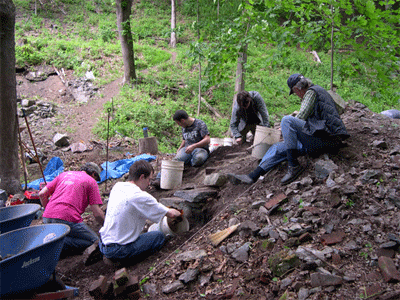Hello! My name is Sarah Mimnaugh and I have just completed my first year in the Industrial Archaeology master’s program at Tech. This is my second field experience, my first being with Western Michigan University at the Fort St. Joseph site in Niles, Michigan. Comparing the different research questions and methods at the two sites has really illuminated the nuances of archaeology for me.
This week we continued our mapping exercises with Tim Goddard very patiently instructing each student on the use of the total station (electronic survey equipment). Those not engaged in mapping spent Monday and Tuesday clearing brush and brick rubble from the surface of future excavation units in the boring mill and moulding shop. Mapping and clearing proved to be great means of familiarizing ourselves with the site we will call home this summer. Further preparing us for the upcoming weeks, Elizabeth Norris conducted a photography workshop, giving those of us unfamiliar with manual settings an opportunity to practice and those with experience time to offer suggestions.
Dr. Sam and Lee Sweitz joined us this week. Lee Sweitz, our field lab coordinator, continued wrapping up her analysis of faunal remains from the 2006 field season and began set up of this season’s lab. Sam joined us in the field, helping open the first excavation unit of the summer, unit 3B, in the moulding shop. We opened two other units this week, unit 3A in the boring mill and 3C in the moulding shop.
Carol Weatherwax volunteered again on the project on Thursday and Friday, helping Sam, Carmelo, John, and Tom expose brick and stone structural remains near a tram entrance into the moulding shop. A large mound of sand piled up in the interior corner of the stone and brick wall is believed to be casting sand dating to the Cornell period.
George, Lawrence, and Megan opened unit 3C inside the moulding shop, working around a mass of tree roots to expose brick structural remains. Units 3B and 3C are believed to be at the two sides of the tram entrance, and their artifact and structural contents will help to answer—and likely pose—questions about the buildings layout as compared to the 1905 blueprint we have of the building.
I have been working in unit 3A along with Seth, Amy, Colleen, and Alessandra. 3A is directly north of 3B and has revealed that the boring mill and moulding shop shared a wall. As Sam and others worked to understand more about the moulding shop, those of us in 3A worked through a thick layer of mortar and rubble to reach what we believe to be the floor inside the boring mill. Numerous corroded iron waste nodules (also dating to the Cornell period) have been recovered from unit 3A, where soil underneath the layer of mortar is iron rich. Much of Friday was spent preparing the unit for official photographs and completing Level 1 paperwork before further excavation and mapping next week.
Our season has just begun here at the West Point Foundry, and we are more than eager to better understand how the boring mill and moulding shop structures interfaced with one another, facilitating important activity at the site. Join us at the Open House during the upcoming Saturday, June 02.

John, Lawrence, Tom, Sam, and George are uncovering the wall in Unit 3B.



